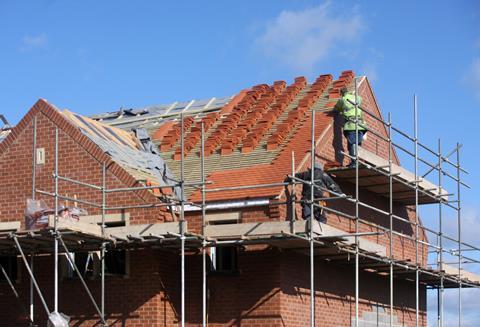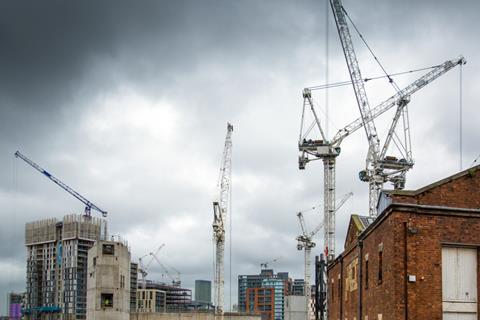Increase in activity at lowest since start of the covid pandemic as purchasing managers also see expectations drop
Growth in housebuilding work flatlined in May, falling to its lowest level since the immediate aftermath of the first covid lockdown, according to a monthly survey of purchasing managers.
The Construction purchasing managers’ index (PMI), compiled by the Chartered Institute of Purchasing and Supply (CIPS) and S&P Global, found that housebuilding activity fell to a figure of 50.7 in May, from 53.8 in April.

The index is calibrated so that any figure above 50 denotes growth in activity, while any figure below denotes contraction.
The figure is the lowest recorded since May 2020 when the industry was in the depths of the first covid-19 lockdown, during which point most housebuilders were forced to shut sites while they figured out how to work safely.
Since then, the housing market has enjoyed a prolonged boom, despite wider economic pressures. It is the third consecutive month that the growth rate has declined, after peaking in February with an index score of 61.5.
The PMI accords with other official data, including official construction output figures and EPC registrations, that suggest housebuilding activity may have peaked at the start of the year.
See also: Are we seeing the start of a housing development slowdown?
The survey found purchasing managers were experiencing a wider growth slowdown in construction, as subdued consumer confidence and concerns about the economic outlook take hold.
Business activity expectations at construction companies are their least upbeat since August 2020.

The headline figure for the index – which measures month-on-month changes in total industry activity – was 56.4 in May, down from 58.2 in April and the lowest reading for four months.
Gareth Belsham, director of the national property consultancy and surveyors Naismiths, said output in residential construciton had “dipped alarmingly close to stagnation territory”.
“Housebuilders are more directly exposed to consumer confidence than any other construction sector; and on this evidence, some resi developers are taking their foot off the gas in response to the slowing economy and rising cost of mortgages,” he said.
Tim Moore, economics director at S&P Global Market Intelligence, said the near stagnation of residential construction activity came amid “signs of softer demand and a headwind from low consumer confidence”.
He added: “Concerns about the business outlook were signalled by a fall in construction sector growth projections to the lowest for more than one-and-a-half years in May.
“Around 19% of construction firms predict an outright decline in business activity during the year ahead, up from just 5% at the start of 2022.”
Higher borrowing costs and intense inflationary pressures were cited by survey respondents as factors likely to hold back growth over the next 12 months. 73% of respondents reported a rise in purchasing prices in May.
Max Jones, director in Lloyds Bank’s infrastructure and construction team, said contractors were “increasingly concerned” about the impact of inflation on growth.
“This is driving discussions about how businesses can best insulate themselves from the challenges it poses – from hedging on certain material costs through to exploring opportunities to raise funds ahead of any broader economic squeeze and having better visibility over cashflow,” he added.
He said more contractors were beginning to adopt innovations and efficiencies already in play across other industries in an attempt to tackle inflationary pressures.
Mark Robinson, group chief executive at procurement body SCAPE, said the figures painted a “concerning picture”, given construction’s traditional position as a bellwether for the wider UK economy.
“It’s vital that we sustain the momentum and goodwill built up during recent months as the reality of price increases continues to take centre stage,” he said.

“Ensuring the pipeline of community-led regenerative construction remains strong will require first-class project management and client engagement to encourage the public sector to press on with the delivery of projects during the challenging times ahead.”
Commercial building and civil engineering were the bright spots in May’s index, the former being the fastest growing sub-sector last month, growing only slightly slower than in April.
Civil engineering activity increased for a fifth month running, though the latest increase in new work was still the slowest since December 2021.
There were positive signals for supplier performance, with delays the least widespread since February 2020, and some firms noted an improvement in product availability despite ongoing logistics bottlenecks, Brexit trade frictions and supplier staff shortages.
Job creation accelerated slightly in May and was the strongest for four months, as firms tried to boost capacity and meet rising customer demand.
But there were widespread reports of recruitment difficulties due to a shortage of skilled workers.











No comments yet